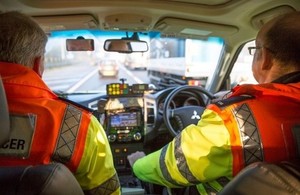Highways England urging motorists to ‘check it before towing it’
Highways England is calling on motorists to ‘check it before towing it’ following dramatic footage showing a trailer rolling down the M25 in Surrey

Traffic Officers
The incident happened on the Surrey/Kent border and caused five miles of tailbacks with delays of around 40 minutes.
There are around 4,000 incidents every year involving all forms of trailers, which equated to around 11 per day in 2017.
With the summer months upon us, Highways England wants anyone towing, before setting off, to ensure they have the correct licence and insurance to tow whatever the weight, that the vehicle is connected correctly and that the load is secure and within the limits for the vehicle.
Highways England’s Strategic Road Safety Lead Stuart Lovatt said:
Thankfully incidents like the one featured in this video are very rare but now is the time to remind motorists of the need to make sure you have carried out proper checks and have loaded the trailer or vehicle correctly.
We have all sorts travelling on our network including horse boxes, trailer tents and leisure vehicles such as boats and caravans. Our message today is really simple, check it before towing it. So that everyone gets home, safe and well.
Simon Smith, MOT Product Manager at the Driver and Vehicle Standards Agency, said:
DVSA’s priority is helping everyone keep their vehicle safe to drive.
Trailer safety is all too often overlooked. But safety checks are life-saving and don’t take too long to carry out – watch and share our clips, social media and read our guidance.
It is the driver’s responsibility to ensure equipment is fitted and used safely on every journey.
And Highways England - the organisation responsible for running England’s major A-road and motorway network - has some handy tips to help keep people safe.
Some of the main factors that Highways England has seen resulting in incidents arise from preventable mistakes, including:
- poor loading (weight in the wrong place – for example towards the rear, rather than concentrated in the middle)
- overloading (too much weight, although often this will also result in bad loading)
- insufficient noseweight - can cause the trailer to sway if the stability is upset by an external factor and may get out of control if not addressed
- trailer too heavy for the towcar’s capability to control it
- speed too high or driving too fast for the road conditions
- really serious crosswinds causing instability to the vehicle
- breakaway cable not attached correctly
Highways England – chair of the National Towing Working Group - is also offering some top tips on what to do if motorists find themselves losing control of the vehicle being towed.
Areas for consideration before setting off include:
- reduce the risk of inherent instability by making sure the outfit is correctly matched (car suitable for the caravan or trailer load) and that it’s correctly loaded, including very importantly that the nose weight is sufficient
- choose a car and caravan/trailer with stability aids, but don’t rely on them to correct an inherently unstable outfit. They will, however, make a safe outfit safer still
- drive within the speed limits for towing – 60mph on a motorway unless signage state slower. Take care when going downhill and/or overtaking to ensure that speed does not build up excessively
- reduce speed if conditions are not favourable (e.g. crosswind)
- when passing or being passed by large vehicles, maximise the separation between themselves and the caravan/trailer by using the available lane width (with due regard for vehicles in other lanes)
- if instability still occurs, do not brake, but instead ease off the accelerator and allow the speed to drop. Let the steering wheel twitch; do not try to steer against the motion of the car. Do not try to accelerate, to ‘pull the outfit straight’. This is likely to result in the return of instability at an even greater speed
- following an instability scare, check all possible contributory factors, and address any which are not optimum to ensure no re-occurrence
Highways England recently launched a national safety campaign advising motorists what to do if they break down and reminds them to follow speed limits, to keep left except when overtaking and not to ignore red X signals above closed lanes.
Highways England has five basic safety tips to follow if your car does break down on a motorway:
- get away from the traffic. Exit the motorway or get to an emergency area or hard shoulder and use the free phone provided
- if that’s not possible, move left onto the verge
- get out of the left side of your car and behind the barrier if you can and it is safe to do so
- get help – contact your breakdown provider or Highways England on 0300 123 5000
- if you break down in moving traffic and cannot leave your car, keep your seatbelt and hazard lights on and call 999
More information about driving on motorways.
More advice on how to carry out a quick and simple trailer safety check.
General enquiries
Members of the public should contact the Highways England customer contact centre on 0300 123 5000.
Media enquiries
Journalists should contact the Highways England press office on 0844 693 1448 and use the menu to speak to the most appropriate press officer.